
How To Organise Customer Feedback Effectively?
Effectively organizing customer feedback is crucial for aligning with business goals and enhancing customer-centric strategies. You can prioritize high-impact areas and improve your offerings by leveraging well-categorized feedback. This process helps you act swiftly on feedback and ensures your customers feel heard, ultimately increasing loyalty and satisfaction.
Importance of Organising Customer Feedback
Organizing customer feedback is crucial for any business seeking to enhance customer experience and product development. When feedback is well-organized, it becomes easier to identify and act on critical insights.
- Prioritizing feedback allows you to focus on what matters most. By segmenting feedback based on factors such as frequency and impact, you can address the issues that significantly affect your customers.
- Collecting feedback from multiple sources provides a comprehensive view of customer opinions and pain points. Each method yields different insights, helping you get a fuller picture of customer needs and preferences.
- Effective organization helps in aligning feedback with business objectives. This ensures that your strategy meets customer expectations and supports your overall goals. Prioritizing feedback by potential business value further aligns customer needs with business success.
- A well-organized feedback repo helps refine your products and services more efficiently. This continuous improvement cycle keeps your offerings relevant and valuable in a competitive market.
- Properly managed feedback also enhances internal communication, making it easier for teams to collaborate on addressing customer concerns.
In sum, effective organization of customer feedback not only aids in immediate problem-solving but also fosters long-term business growth through informed decisions and improved customer satisfaction.
Collecting Customer Feedback
Effective customer feedback collection requires gathering insights from diverse channels and consolidating them to ensure meaningful analysis and action.
Gather Feedback From Multiple Channels
Utilize different methods to gather comprehensive customer feedback. These include email surveys, in-app surveys, live chat, and customer interviews. Each channel offers unique advantages.
For instance, in-app surveys provide real-time insights while using your product. On the other hand, email surveys allow for more detailed, reflective responses. Community forums and social media can also be valuable, as they capture spontaneous customer thoughts and ideas.
Surveys
Surveys are a classic way of getting customer feedback. You can send surveys to your customers via email or even pop them up in your product. Use a combination of multiple-choice and open-ended customer feedback questions for comprehensive feedback.
Feedback Portals
Create a centralized place for product feedback to keep track of different types of customer feedback and improve SaaS products while listening to their customers. Rapidr helps SaaS companies be more customer-centric by consolidating feedback across different apps, prioritizing requests, having a discourse with customers, and closing the feedback loop.
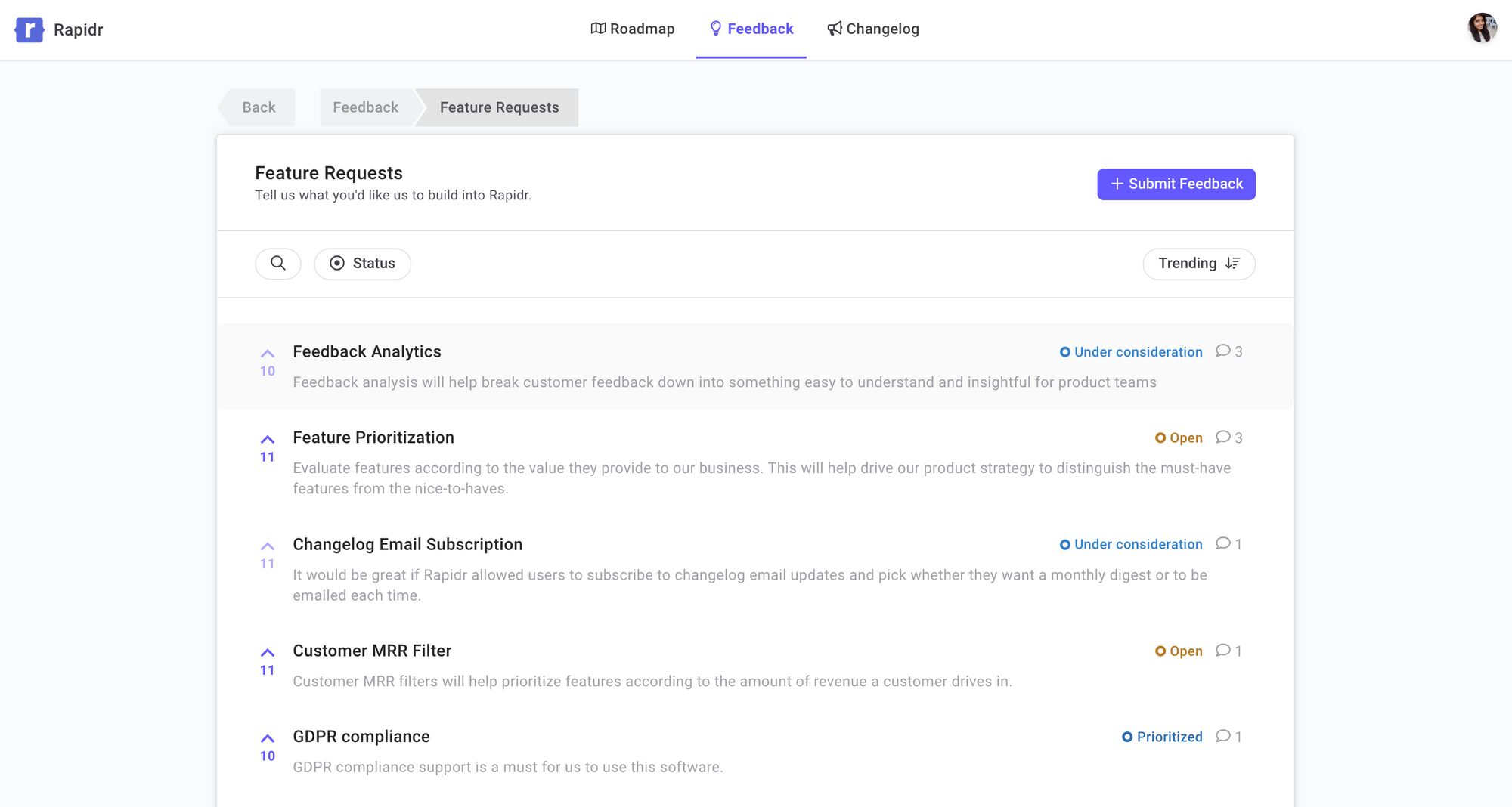
Feedback Forms
Integrate feedback forms directly within your software with feedback management systems. Prompt users to provide feedback after certain actions or on particular screens. Make sure these forms are not intrusive to the user experience.
In-app Feedback
Utilize in-app feedback platforms to ask users about their experiences in real-time. This can be done through chatbots or pop-up messages, prompting immediate feedback while the user is engaged with the product.
Rapidr's deep Intercom Integration makes it easy for your product and customer success teams to track incoming feedback on Intercom.

Emails
Personalized emails can be an effective way to gather feedback. Depending on your relationship with the customer, the approach can range from casual (e.g., "We noticed you've been using our product for a while and would love to hear your thoughts") to more formal.
User Interviews
If your SaaS product is complex or needs in-depth insights, conducting one-on-one user interviews can be invaluable. They allow you to understand your customers' needs, pain points, and overall experience with your product. Users can provide insight into your product roadmap, new feature ideas, and their overall experience.
Usability Tests
Collect beta testing feedback by asking a group of customers to test new features of your product. You can do this through various platforms by organizing beta-testing groups among your customers.
Social Media & Online Forums
Monitor your company's social media profiles and any online community feedback forums where your product might be discussed. You can gather feedback from these discussions or even ask questions directly.
Customer Support
Your customer support team often interacts directly with customers and hears their pain points and praises first-hand. Ensure there's an internal team feedback system setup for this valuable information to be collected from customer-facing teams and shared with the product team.
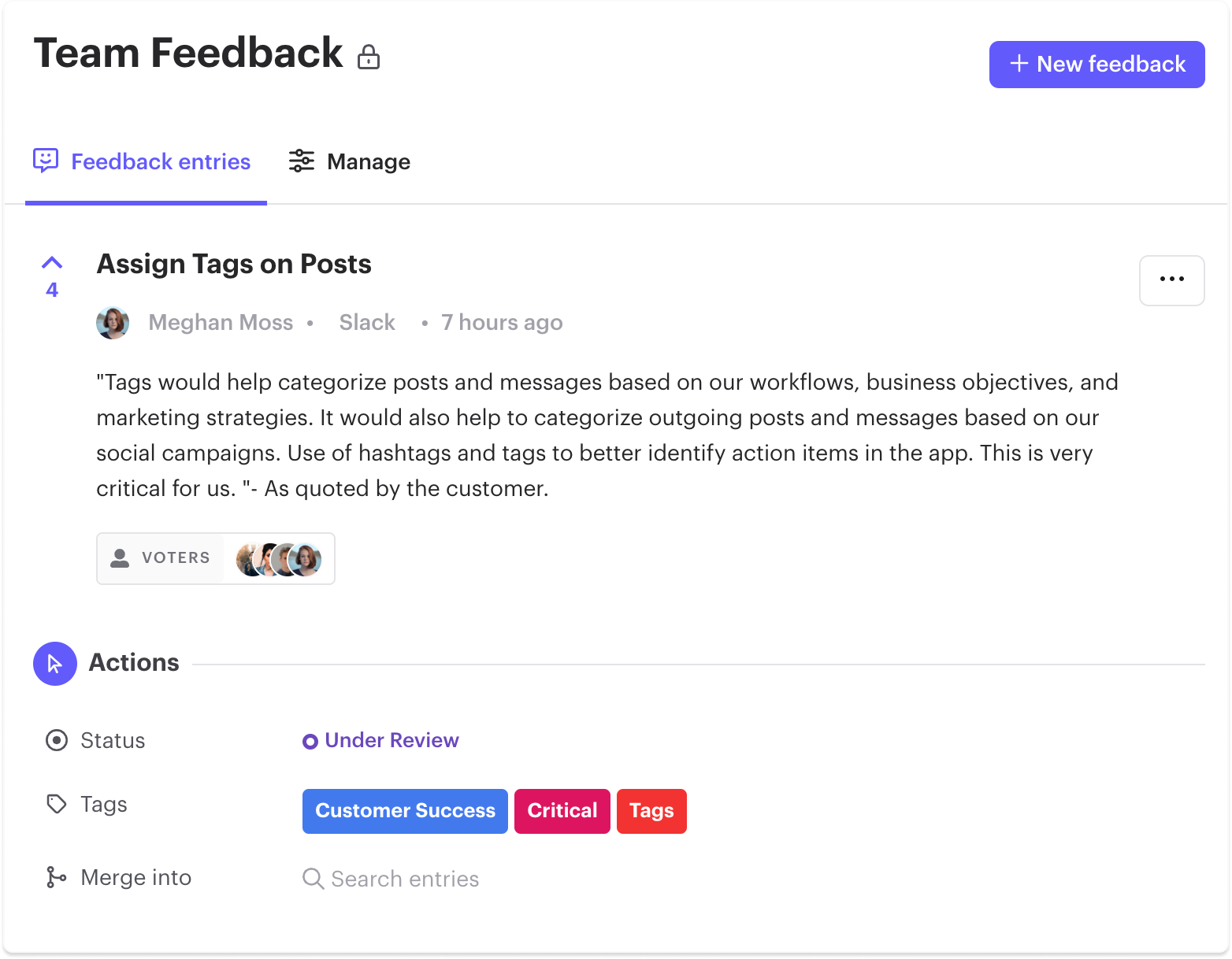
Also, it's essential to close the feedback loop. Let your customers know that their feedback has been heard and appreciated, and update them on the changes you're making based on their input. This will make them feel valued and encourage them to continue providing feedback in the future.
Create a Centralized Feedback Repository
Establish a single location for all feedback. This will ensure that no valuable input is lost and make it easier to analyze trends.
Consider utilizing feedback management software to streamline this process. These tools can collect feedback data from multiple sources and present it in an organized manner. Having a centralized repository helps quickly access and review feedback, leading to faster decision-making.
Merge Similar Feedback to Avoid Duplicates
After collecting feedback, you must refine it by merging similar entries. This prevents the duplication of effort and ensures that the feedback data is clean and actionable.
Rapidr suggests similar feedback to a user when creating a new one if similar feedback exists. Even if duplicate feedback is created, it allows users to merge similar-looking feedback into one to avoid creating duplicates.
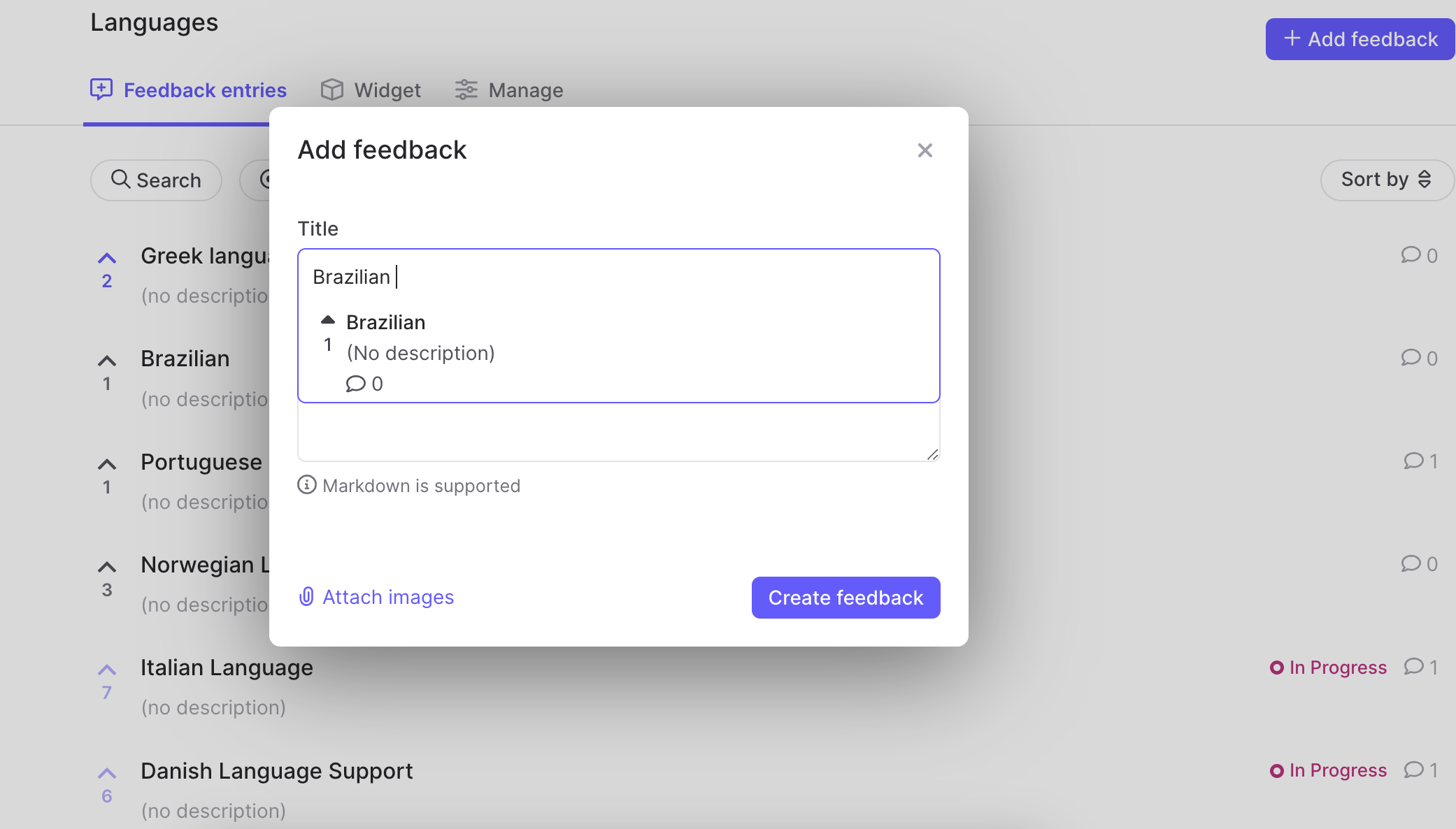
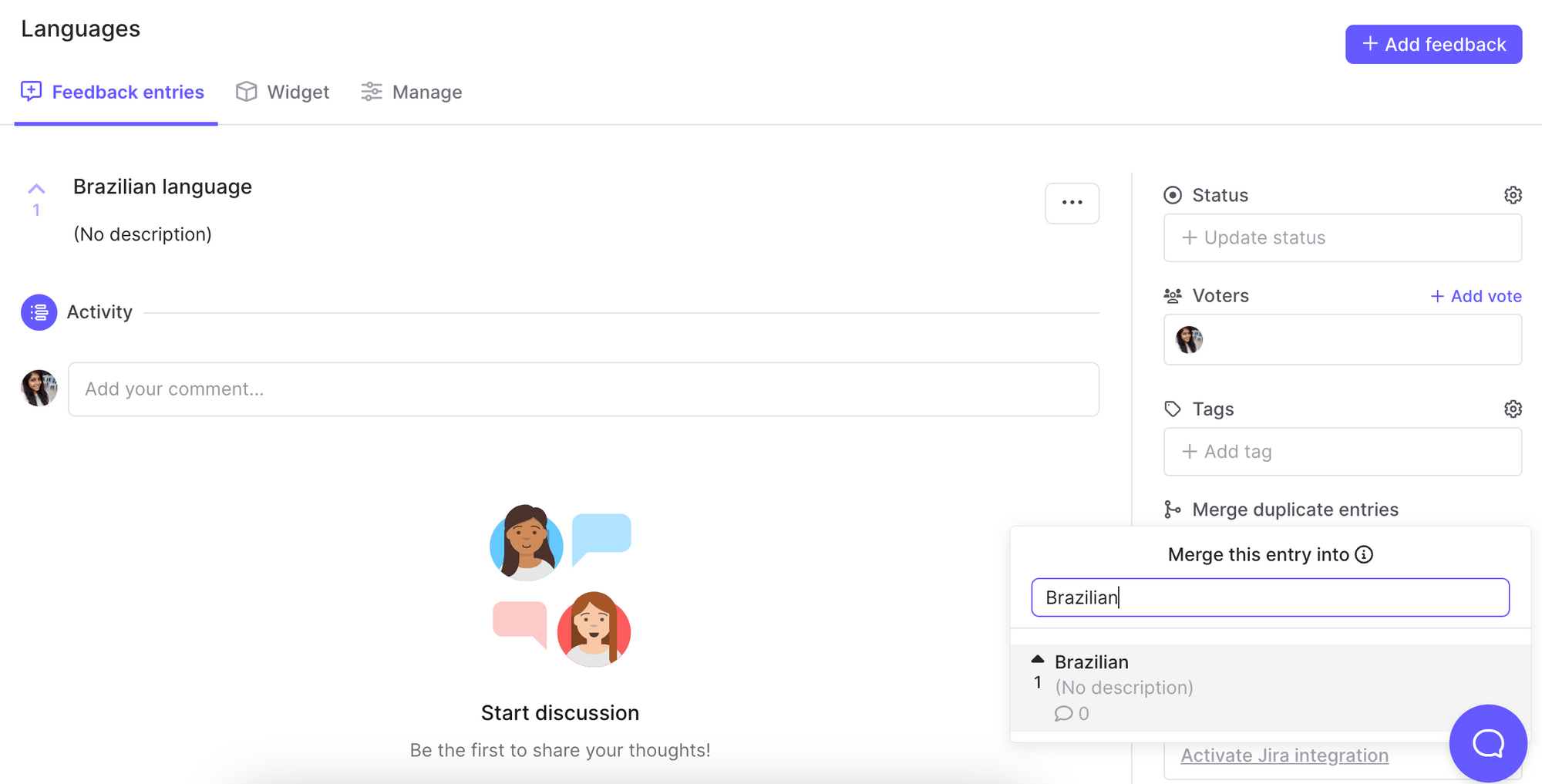
Grouping similar suggestions and concerns reduces redundancy and highlights the most critical areas needing attention.
Categorize, Tag, and Segment Feedback Requests
Organize your feedback by categorizing it into relevant groups. For example, you could categorize it into themes like usability, pricing, or service quality. You could also use filters to organize the feedback by demographic, product, or service line. Then, sort by date, urgency, or votes in Rapidr.
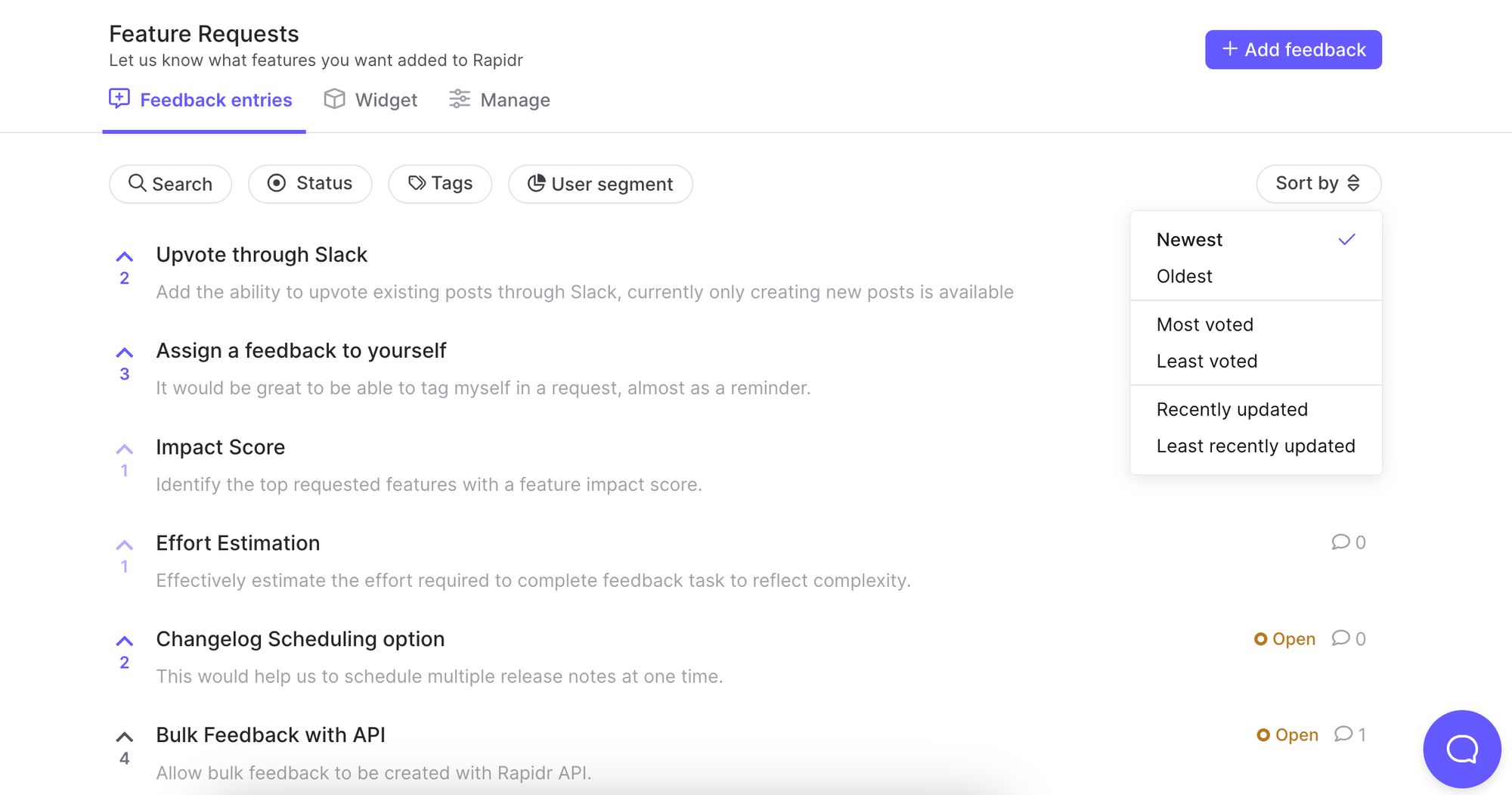
Tagging feedback can help you segment requests based on various criteria, such as urgency, feedback status, product area, or customer type.
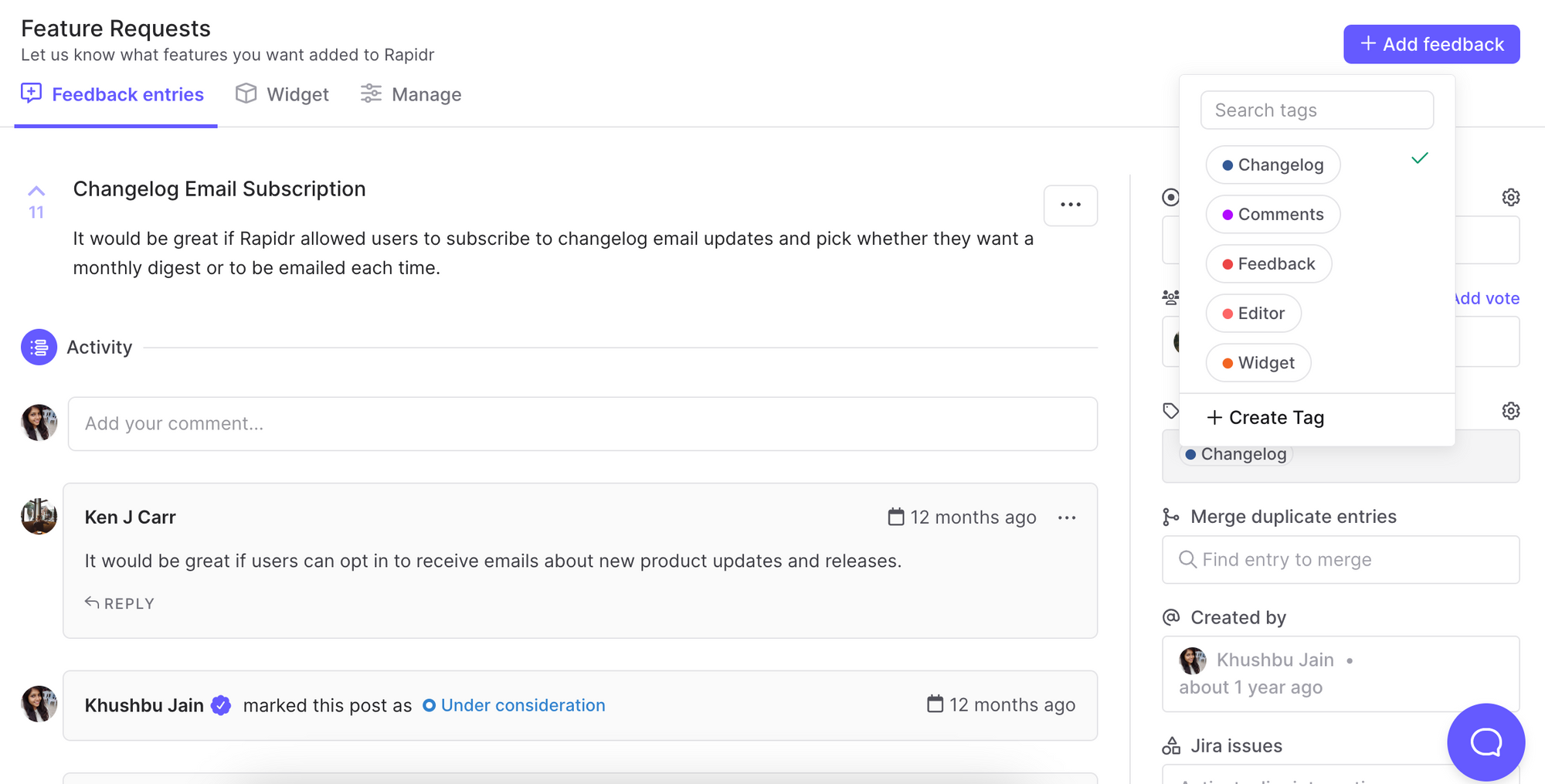
For instance, break feedback into categories such as "feature requests," "bug reports," and "customer support." Tagging and categorizing make prioritizing feedback based on strategic goals and customer needs easier. By systematically organizing feedback, you can address critical issues promptly and efficiently.
Use user segments and statistical methods to interpret results and find correlations and conclusions for quantitative data.
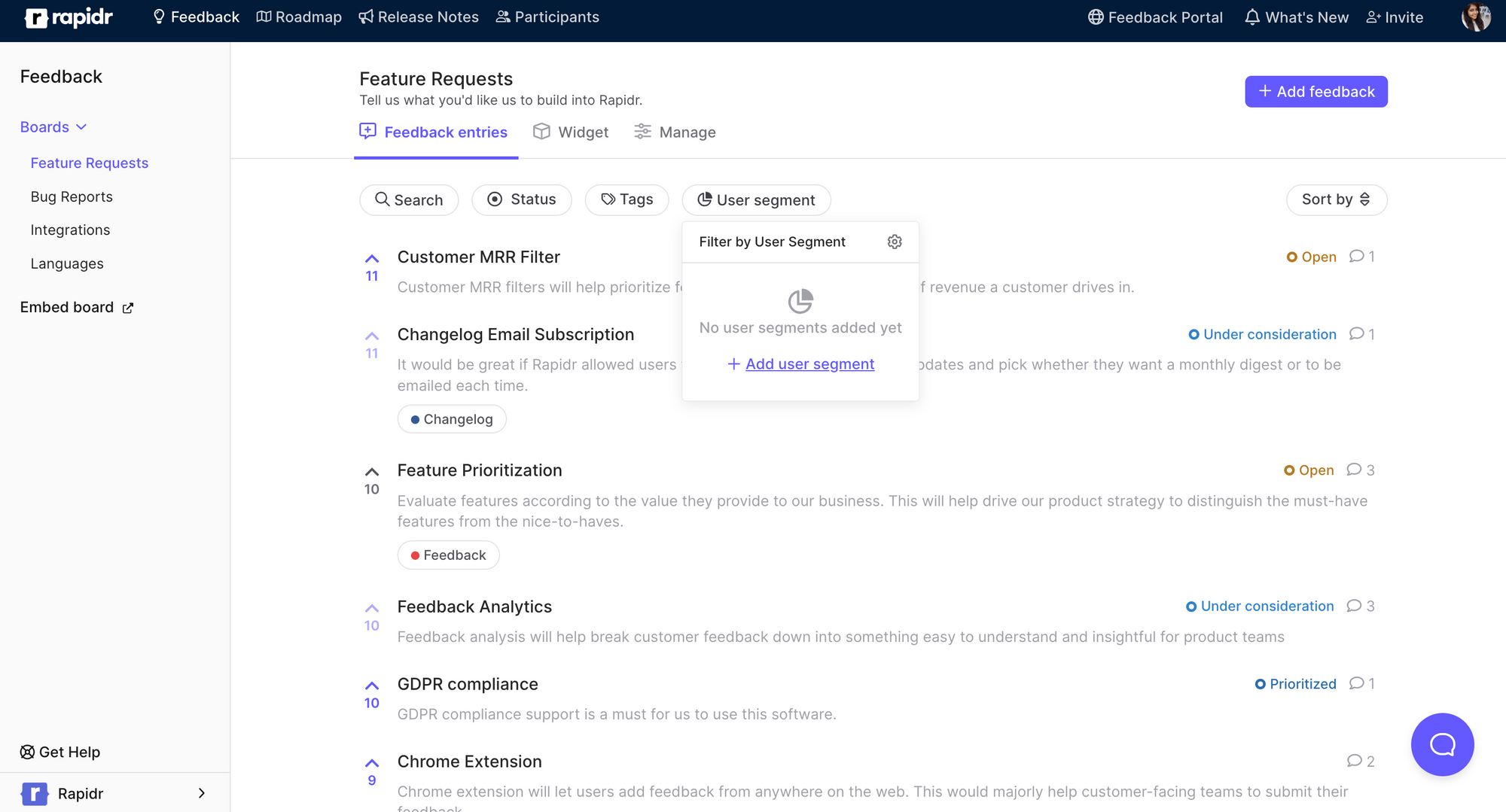
In summary, gather feedback from diverse channels, create a centralized repository, merge similar feedback, and categorize and tag requests to streamline customer feedback management.
Analysing Customer Feedback
Understanding both quantitative and qualitative insights is crucial for effectively analyzing customer feedback. This approach allows you to comprehensively view customer sentiment and make informed decisions.
Quantitative Insights
Quantitative insights involve analyzing numerical data from feedback. This could include survey ratings, response frequencies, or metrics from feedback management software. You can identify patterns and trends using tools like spreadsheets or specialized data analysis software.
For example, feedback collected from customer feedback surveys or in-app surveys can be quantified to determine satisfaction scores. Email surveys also provide valuable numerical data that can be statistically analyzed to gauge customer experience. Live chat analytics offer real-time feedback metrics for immediate action.

Qualitative Insights
Qualitative insights focus on detailed, textual feedback. This type of analysis involves interpreting open-ended responses to understand customer feelings and opinions. Methods include customer interviews, feedback forms, and community forums.
Feedback management software like Rapidr helps categorize and tag feedback, identifying recurring themes or issues. Sentiment analysis can also gauge the overall sentiment from textual data, providing a deeper understanding of customer needs and concerns.
Analyzing user feedback data can provide valuable insights that drive product development and improvement. By combining these approaches, you ensure a holistic analysis of customer feedback.
Prioritizing Customer Feedback
Effectively prioritizing feedback requires a balance between quantitative and qualitative insights. Different methods and tools, such as customer feedback surveys and community forums, can help you gather and manage this feedback.
Prioritization aims to deliver value to customers as quickly and efficiently as possible while still giving them an enjoyable experience. Feedback prioritization can help you evaluate which features will provide the most value for your customer base and make those your priority.
- Surveying: Use structured questions to gather specific data. In-app surveys and email surveys are practical options.
- Feedback Management Software: Tools that provide metrics and analytics, such as the frequency of feedback, help identify recurring issues.
- Customer Interviews: Provide detailed stories and personal experiences highlighting the issues' importance and urgency.
- Live Chat and Community Forums: Real-time interactions and discussions often reveal nuanced issues that are not captured in surveys.
Balancing data with these personal insights allows you to address both widespread and specific concerns, improving overall customer satisfaction. These methods simplify the identification of high-impact areas that require immediate attention, ensuring resources are allocated efficiently.
Act on the feedback
To effectively act on feedback, you need to prioritize it and create actionable plans. This involves building a detailed roadmap based on the feedback collected from various sources such as in-app surveys, email surveys, and live chat.
Build a roadmap
Creating a structured roadmap starts with categorizing the feedback received from different channels. Use feedback management software to streamline this process.
Next, prioritize feedback based on its impact and feasibility. Consider using a scoring system to quantify the importance of each piece of feedback. Develop a detailed plan of action for top-priority items. Assign specific tasks to team members, set deadlines, and ensure regular follow-ups.
Communicate changes to all stakeholders, including customers. Use customer interviews and community forums to continuously gather insights and improve.
It's impossible to say yes to all ideas, but the right ones can help guide your product roadmap. It is equally important to respond to negative feedback as it is to collect feedback in the first place. Ensure your customer success teams are involved in the feedback loop to foster customer loyalty and retention.
You can monitor progress and update the roadmap as new feedback is collected. This iterative approach ensures you consistently address the most critical customer needs. Keep them in the loop about which requests are in progress or planned and which are done with a public roadmap offered by Rapidr.
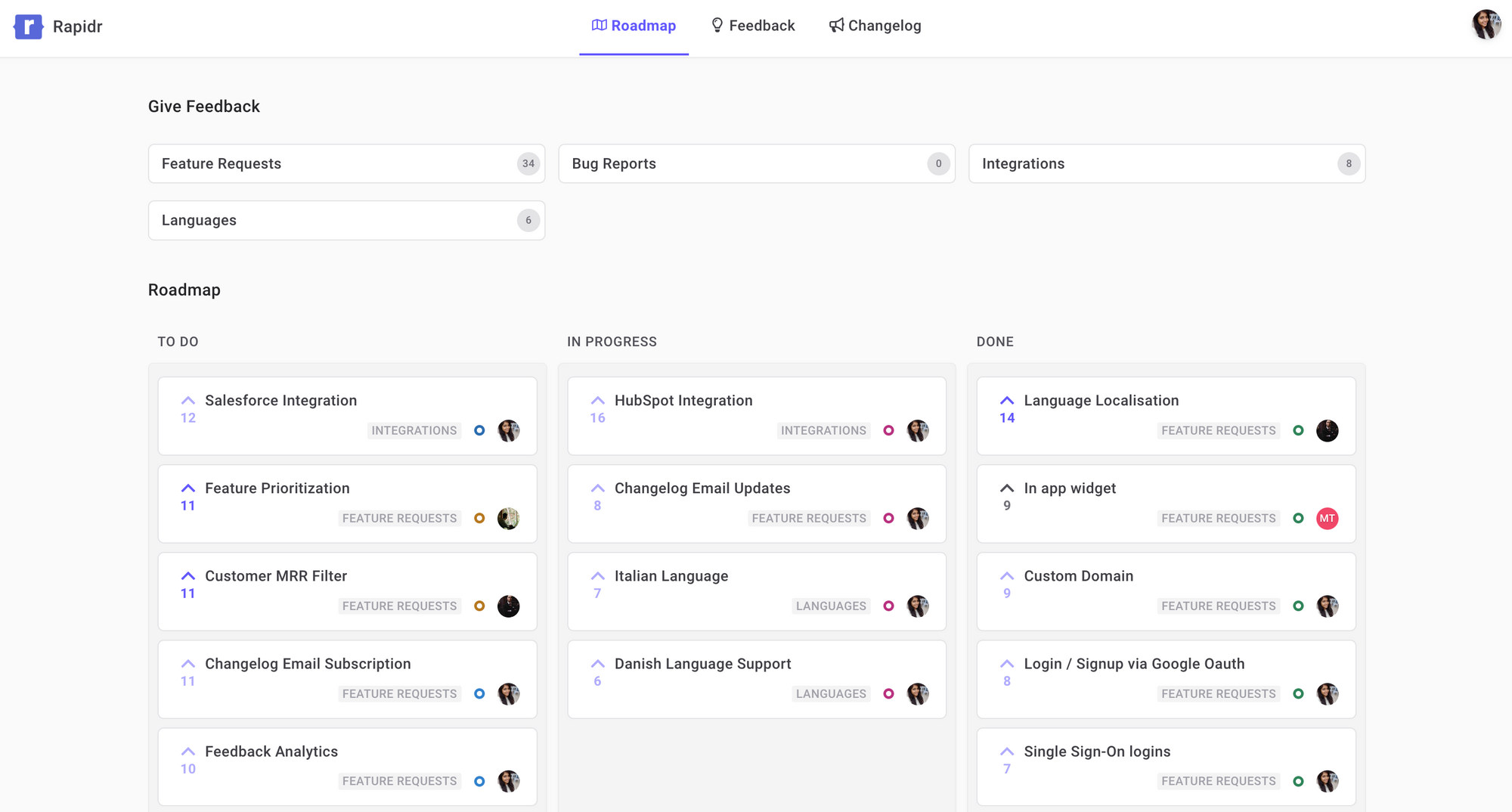
Close the Feedback Loop
To close the feedback loop effectively, it's essential to acknowledge and respond to customer feedback, keeping users informed about changes made based on their input. This process helps build trust and shows customers that their opinions are valued.
Share Updates with Changelog
Communicating updates through a changelog ensures transparency. A changelog is a concise record of all changes made to a product or service. Using feedback management software to compile feedback from in-app surveys, email surveys, and live chat can make this process smoother.
Closing the feedback loop includes informing customers about the actions you've taken. This may involve:
- Updating them on new features and improvements.
- Sharing roadmap changes via newsletters or in-app messages.
- Highlighting how feedback has influenced product evolution.
When you release new features or updates, reach out to users to see how they find them. Clear communication is vital to cohesive development, even if it means saying no to some feature requests. Following up shows that you act on customer feedback, strengthening loyalty and ensuring your company remains customer-centric.

You should regularly update the changelog to include improvements driven by customer feedback. Make this accessible directly within your app or on your website. Acknowledging specific feedback helps customers see the direct impact of their input.
Consider including links to discussions from community forums in your changelog. This practice can increase customer satisfaction by demonstrating that their suggestions lead to real action.
Conclusion
Effectively organizing customer feedback is vital for improving your product and meeting customer needs. Prioritize the feedback that aligns with your business goals and target audience.
Use a customer feedback management system that centralizes feedback collection, organization, and tracking. This ensures that all feedback is easily accessible and actionable.
Rapidr is a feedback management software and feature tracking tool that helps manage the entire feedback lifecycle, from capturing feature requests to prioritizing features, informing product roadmap, and sharing product updates with changelog.
Rapidr allows you to capture and track all user feedback and organize and analyze them under one roof in a centralized location. Then, inform your roadmap with the most critical feedback, and notify users of what's new with release notes.
- Rapidr is an end-to-end customer feedback management solution, so you don't have to glue multiple apps together. With it, you get a customer feedback management tool, feature request collection software, road mapping software, and release notes software.
- Rapidr is one of the most modern and cost-effective solutions, and its pricing is based on the weight you derive from the software instead of per-seat pricing.
- Rapidr can be fully white-labeled on high-end plans, which means no visible branding and is built to support varying workflows and to be customizable from day one.
- Rapidr supports major integrations such as HubSpot, Jira, Intercom, Slack, SAML SSO, etc., and many more at the time of writing to collect and manage customer feedback.
- Rapidr is relatively new in the market, and many features are still being built and tracked on their public feedback board.
Remember, a structured approach to feedback will help you continuously improve and keep your customers satisfied. This will ultimately foster loyalty and drive success for your business.

